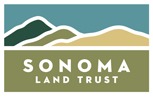HOW TO PROTECT YOUR LAND
Conservation Easement
One of the most effective and flexible mechanisms for the permanent protection of private lands is a conservation easement. A conservation easement is a voluntary legal agreement between a landowner and Sonoma Land Trust that restricts the use of a particular property in order to protect its conservation values. Conservation easements are used to achieve a variety of purposes, including open space preservation, agricultural use and natural resource protection. Landowners retain title to the land and continue to occupy and use the land under the terms of the easement.
A conservation easement is an excellent tool for families that wish to keep their land intact to pass on to the next generation. An easement is negotiated for each specific property based on the preservation goals of the landowner and Sonoma Land Trust. For example, easements may prohibit development over scenic landscapes, prohibit non-agricultural uses on farms and ranches, restrict timber harvests to sustainable levels on forest lands or require that land be kept “forever wild” to preserve natural areas. The conservation easement is recorded in the form of a grant deed and is binding on successive owners of the property in perpetuity. In other words, it is forever.
A landowner may sell a conservation easement, but usually easements are donated. If the donation benefits the public by permanently protecting important conservation resources and meets other federal tax code requirements, it can qualify as a tax-deductible charitable donation. The amount of the donation is the difference between the land’s value with the easement and its value without the easement. Placing an easement on property may or may not result in property tax savings.
